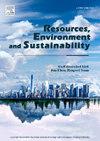Is ‘local food’ best? Evaluating agricultural greenhouses in Switzerland as an alternative to imports for reducing carbon footprint
IF 12.4
Q1 ENVIRONMENTAL SCIENCES
引用次数: 0
Abstract
Sustainable agricultural practices are essential to mitigate environmental impacts. Greenhouse cultivation offers potential solutions for enhancing crop yields and reducing the impacts on land and water resources. However, reliance on fossil-based heating systems poses challenges regarding carbon footprint. This study provides a comparative life cycle assessment (LCA) of the carbon and water footprints of imported and locally produced greenhouse crops in Switzerland, considering the local climatic conditions and the predominant production systems in different regions. The findings reveal that the carbon footprint is primarily driven by heating, supplementary lighting, and CO2 fertilization, while transportation emissions are relatively minor. A key insight is that using waste heat for greenhouse heating in Switzerland can reduce the carbon footprint to less than one-third (e.g., 0.6 CO2-eq/kg for tomatoes) compared to local natural-gas-based heating systems. However, imports from warmer locations still show a slightly lower carbon footprint (0.4-0.5 CO2-eq/kg) due to the absence of heating, lighting, and CO2 enrichment, but often come with trade-offs concerning the water footprint. Seasonal variations also strongly influence the carbon footprint: early winter cultivation can result in up to five times higher carbon footprint than summer cultivation, while waste-heat systems reduce but do not eliminate this effect. These findings highlight the potential of waste-heat-based greenhouses as a lower-carbon alternative to fossil-fueled domestic production and imports from less favorable climates while underscoring the environmental benefits of seasonal diets.

“本地食物”最好吗?评估瑞士的农业温室作为减少碳足迹的进口替代方案
可持续农业做法对减轻环境影响至关重要。温室栽培为提高作物产量和减少对土地和水资源的影响提供了潜在的解决方案。然而,对化石燃料供暖系统的依赖带来了碳足迹方面的挑战。考虑到当地气候条件和不同地区的主要生产系统,本研究对瑞士进口和本地生产的温室作物的碳和水足迹进行了比较生命周期评估(LCA)。研究结果表明,碳足迹主要由供暖、补充照明和二氧化碳施肥驱动,而交通排放相对较小。一个关键的见解是,与当地的天然气供暖系统相比,在瑞士使用废热为温室供暖可以将碳足迹减少到不到三分之一(例如,西红柿每公斤0.6二氧化碳当量)。然而,由于缺乏供暖、照明和二氧化碳富集,从较温暖地区进口的碳足迹仍略低(0.4-0.5 CO2当量/kg),但往往需要在水足迹方面进行权衡。季节变化也对碳足迹产生强烈影响:早冬栽培的碳足迹可能比夏季栽培高出5倍,而废热系统减少但不能消除这种影响。这些发现强调了废热温室作为化石燃料国内生产和从不太有利气候进口的低碳替代品的潜力,同时强调了季节性饮食的环境效益。
本文章由计算机程序翻译,如有差异,请以英文原文为准。
求助全文
约1分钟内获得全文
求助全文
来源期刊

Resources Environment and Sustainability
Environmental Science-Environmental Science (miscellaneous)
CiteScore
15.10
自引率
0.00%
发文量
41
审稿时长
33 days
 求助内容:
求助内容: 应助结果提醒方式:
应助结果提醒方式:


